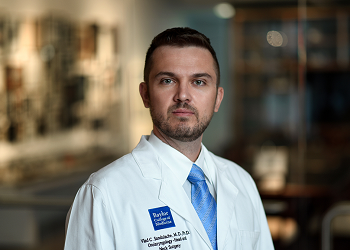Know your risk for developing head and neck cancer
You can never prepare yourself to hear the words, “you have cancer.” However, for some types of cancer, there are screenings you can get to help with early detection and increase survival. Through World Head and Neck Cancer Day on July 27, the International Federation of Head and Neck Oncologic Societies encourages head and neck cancer awareness.
Standardized tests are recommended for certain cancers, such as cancers of the breast, prostate and colon, but there is no widely-accepted screening test for head and neck cancers. Regular dental checkups and cleanings, along with regular clinical evaluations by primary care physicians, can provide important opportunities for early detection.
However, Dr. Vlad Sandulache, assistant professor of otolaryngology – head and neck surgery at Baylor College of Medicine, says that in the absence of specific screening tests, patient and primary care provider awareness of cancer risks is key.
Traditional risk factors associated with development of head and neck cancer include tobacco and alcohol use. Over the last two decades, it has become clear that exposure to the human papilloma virus (HPV) is also linked to the development of head and neck cancer, particularly of the oropharynx. HPV is not the first virus to be associated with head and neck cancer.

“Development of nasopharyngeal carcinoma [affecting the area behind the nasal cavities] is associated with exposure to the Epstein-Barr virus (EBV), particularly in Asian countries,” he said. “We now have evidence that at least two viruses are associated with development of head and neck cancer.”
Sandulache added that patients who have had head and neck cancer at one site are more likely to develop cancer at other head and neck sites, so it is important that patients receive lifelong follow-up after diagnosis and treatment.
“Vaccinations for HPV are essential to reduce the risk of developing HPV-associated malignancies. Pap smears have become standard care for the diagnosis of cervical cancer in women, but we have no proven screening tests for oropharyngeal cancer for men or women,” he said.
“Until such tests become available, the only thing that people of the right age can do to decrease their cancer risk is to get vaccinated and to make regular visits to their dentist and primary care provider. We don’t have any other way of predicting or preventing the development of head and neck cancer,” he said.
Since everyone is potentially at risk of head and neck cancer, Sandulache says it is important not to ignore possible symptoms.
“Infections come and go in days to weeks; cancers develop and progress in weeks to months,” he said. “Symptoms such as a sore throat or nasal congestion that persist for weeks or months could possibly be a sign of a more serious condition, such as malignancy.”
Head and neck cancer can be a devastating disease. A tumor that progresses can take away the ability to interact with others and rob you of your quality of life, he says.
“It’s a natural human tendency to deny and ignore symptoms. We want to make sure that people understand that this is a problem that is much better tackled early,” Sandulache said. “If you are treated early, you have a better chance of a cure and your quality of life will be better.”
Treatment for head and neck cancer is complex and requires a specialized multidisciplinary team that includes surgical, radiation and medical oncologists along with speech and language pathologists and registered dietitians. Because head and neck cancer is relatively uncommon compared to other malignancies, treatment is best obtained in large academic centers, which can provide multidisciplinary care in an efficient and timely fashion.
Additional Resources
To visit with a Baylor otolaryngologist, make an appointment online or call 713-798-5900.
Oral, head and neck cancer and HPV: What you should know




Pingback: What’s the link between HPV and head and neck cancer?